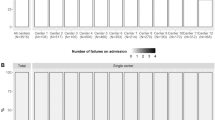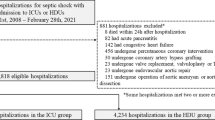Abstract
Resource allocation in our overcrowded hospitals would require classification of inpatients according to the severity of illness, the evolving risk and the clinical complexity. Reverse triage (RT) is a method used in disasters to identify inpatients according to their use of hospital resources. The aim of this observational prospective study is to evaluate the use of RT in medical inpatients of an Italian Hospital and to compare the RT score with National Early Warning Score, Sequential Organ Failure Assessment and Charlson Comorbidity Index. Cluster sampling was performed on high dependency unit (HDU), geriatrics (Ger) and internal medicine (IM) wards. We calculate RT, NEWS, SOFA and CCI from inpatient charts. Length of stay (LOS), transfer to a higher level of care, death and discharge date were collected after 30 days. We obtained demographics, comorbidities, severity and clinical complexity of 260 inpatients. We highlighted differences in NEWS, SOFA and CCI in the three divisions. On the contrary RT score was uniformly high (median 7), with 85% of patients with RT = 8. NEWS, SOFA and CCI were higher in patients with higher RT score. We used the sum of the interventions listed by RT (RT sum) as a proxy of the level of care needed. RT-sum showed moderate correlation with NEWS (r = 0.52 Spearman, p < 0.001). RT-sum was the highest in HDU, related to the evolving severity of HDU patients. Ger patients that showed the highest CCI score (with all patients in the CCI ≥ 3 category) had the second highest RT-sum. RT score showed similar values in the majority of the inpatients regardless of differences in NEWS, SOFA and CCI in different ward subgroups. RT-sum is related both to evolving severity (NEWS) and to clinical complexity (CCI). RT and NEWS could predict inpatient level of care and resource need associated with CCI.

Similar content being viewed by others
References
Clark DE, Ryan LM (2002) Concurrent prediction of hospital mortality and length of stay from risk factors on admission. Health Serv Res. 37(3):631–645
Institute of Medicine (2007) Hospital-based emergency care: at the breaking point. The National Academies Press, Washington, DC. https://doi.org/10.17226/11621
Moskop JC, Sklar DP, Geiderman JM, Schears RM, Bookman KJ (2009) Emergency department crowding, part 1—concept, causes, and moral consequences. Ann Emerg Med 53:605–611
Pelayo S, Santos R (2016) Human Factors and Organizational Issues in 2015: the increasing complexity of the healthcare domain calls for more comprehensive approaches. Yearbook Med Inform 1:126–129. https://doi.org/10.15265/IY-2016-043
Islam R, Weir C, Fiol GD (2016) Clinical complexity in medicine: a measurement model of task and patient complexity. Methods Inf Med 55(1):14–22. https://doi.org/10.3414/ME15-01-0031
Knaus WA, Draper EA, Wagner DP (1985) APACHE II: a severity of disease classification system. Crit Care Med. 3(10):818–829
Vincent JL, Moreno R, Takala J, Willatts S, De Mendonça A, Bruining H, Reinhart CK, Suter PM, Thijs LG (1996) The SOFA (Sepsis-related Organ Failure Assessment) score to describe organ dysfunction/failure. On behalf of the Working Group on Sepsis-Related Problems of the European Society of Intensive Care Medicine. Intensive Care Med 22(7):707–710
Cárdenas-Turanzas M, Ensor J, Wakefield C, Zhang K, Wallace SK, Price KJ, Nates JL (2012) Cross-validation of a Sequential Organ Failure Assessment score-based model to predict mortality in patients with cancer admitted to the intensive care unit. J Crit Care. 27(6):673–680. https://doi.org/10.1016/j.jcrc.2012.04.018 (Epub 2012 Jul 2)
Zaccone V, Tosoni A, Passaro G, Vallone CV, Impagnatiello M, Li Puma DD, De Cosmo S, Landolfi R, Mirijello A, Internal Medicine Sepsis Study Group (2017) Sepsis in Internal Medicine wards: current knowledge, uncertainties and new approaches for management optimization. Ann Med. 27:1–11. https://doi.org/10.1080/07853890.2017.1332776
Pedersen NE, Rasmussen LS, Petersen JA, Gerds TA, Østergaard D, Lippert A (2017) A critical assessment of early warning score records in 168,000 patients. J Clin Monit Comput. https://doi.org/10.1007/s10877-017-0003-5
Malycha J, Bonnici T, Sebekova K, Petrinic T, Young D, Watkinson P (2017) Variables associated with unplanned general adult ICU admission in hospitalized patients: protocol for a systematic review. Syst Rev 6(1):67. https://doi.org/10.1186/s13643-017-0456-0
Durusu Tanrıöver M, Halaçlı B, Sait B, Öcal S, Topeli A (2016) Daily surveillance with early warning scores help predict hospital mortality in medical wards. Turk J Med Sci 46(6):1786–1791. https://doi.org/10.3906/sag-1411-101
Williams TA, Tohira H, Finn J, Perkins GD, Ho KM (2016) The ability of early warning scores (EWS) to detect critical illness in the prehospital setting: A systematic review. Resuscitation 102:35–43. https://doi.org/10.1016/j.resuscitation.2016.02.011
Petersen JA, Antonsen K, Rasmussen LS (2016) Frequency of early warning score assessment and clinical deterioration in hospitalized patients: a randomized trial. Resuscitation 101:91–96. https://doi.org/10.1016/j.resuscitation.2016.02.003
Capan M, Ivy JS, Rohleder T, Hickman J, Huddleston JM (2015) Individualizing and optimizing the use of early warning scores in acute medical care for deteriorating hospitalized patients. Resuscitation 93:107–112. https://doi.org/10.1016/j.resuscitation.2014.12.032
McGaughey J, Alderdice F, Fowler R, Kapila A, Mayhew A, Moutray M (2007) Outreach and Early Warning Systems (EWS) for the prevention of intensive care admission and death of critically ill adult patients on general hospital wards. Cochrane Database Syst Rev 3:CD005529
Kim WY, Lee J, Lee JR, Jung YK, Kim HJ, Huh JW, Lim CM, Koh Y, Hong SB (2017) A risk scoring model based on vital signs and laboratory data predicting transfer to the intensive care unit of patients admitted to gastroenterology wards. J Crit Care 40:213–217. https://doi.org/10.1016/j.jcrc.2017.04.024
Siddiqui S, Chua M, Kumaresh V, Choo R (2017) A comparison of pre ICU admission SIRS, EWS and q SOFA scores for predicting mortality and length of stay in ICU. J Crit Care. 41:191–193. https://doi.org/10.1016/j.jcrc.2017.05.017.3
Charlson ME et al (1987) A new method of classifying prognostic comorbidity in longitudinal studies: development and validation. J Chron Dis 40:373–383
Yurkovich M, Avina-Zubieta JA, Thomas J, Gorenchtein M, Lacaille D (2015) A systematic review identifies valid comorbidity indices derived from administrative health data. J Clin Epidemiol. 68(1):3–14. https://doi.org/10.1016/j.jclinepi.2014.09.010
Kaji AH, Koenig KL, Lewis RJ (2007) Current hospital disaster preparedness. JAMA 298(18):2188–2190
Peleg K, Kellermann AL (2009) Enhancing hospital surge capacity for mass casualty events. JAMA 302(5):565–567. https://doi.org/10.1001/jama.2009.1119
Bayram JD, Zuabi S, Subbarao I (2011) Disaster metrics: quantitative benchmarking of hospital surge capacity in trauma-related multiple casualty events. Disaster Med Public Health Prep 5(2):117–124. https://doi.org/10.1001/dmp.2010.19
Einav S, Hick JL, Hanfling D, Erstad BL, Toner ES, Branson RD, Kanter RK, Kissoon N, Dichter JR, Devereaux AV, Christian MD (2014) Surge capacity logistics: care of the critically ill and injured during pandemics and disasters: CHEST consensus statement. Chest. 146(4 Suppl):e17S–43S. https://doi.org/10.1378/chest.14-0734
Pollaris G, Sabbe M (2016) Reverse triage: more than just another method. Eur J Emerg Med 23(4):240–247
Kelen GD, Kraus CK, McCarthy ML, Bass E, Hsu EB, Li G, Scheulen JJ, Shahan JB, Brill JD, Green GB (2006) Inpatient disposition classification for the creation of hospital surge capacity: a multiphase study. Lancet. 368(9551):1984-90
Kelen GD, Sauer L, Clattenburg E, Lewis-Newby M, Fackler J (2015) Pediatric disposition classification (reverse triage) system to create surge capacity. Disaster Med Public Health Prep 9(3):283–290. https://doi.org/10.1017/dmp.2015.27 (Epub 2015 Mar 27)
Kelen GD, Troncoso R, Trebach J, Levin S, Cole G, Delaney CM, Jenkins JL, Fackler J, Sauer L (2017) Effect of reverse triage on creation of surge capacity in a pediatric hospital. JAMA Pediatr 171(4):e164829. https://doi.org/10.1001/jamapediatrics.2016.4829 (Epub 2017 Apr 3)
Kelen GD, McCarthy ML, Kraus CK, Ding R, Hsu EB, Li G, Shahan JB, Scheulen JJ, Green GB (2009) Creation of surge capacity by early discharge of hospitalized patients at low risk for untoward events. Disaster Med Public Health Prep 3(2 Suppl):S10-6. https://doi.org/10.1097/dmp.0b013e3181a5e7cd
Burkle FM Jr (2017) Pediatric reverse triage-uncomfortable but real decision making for community preparedness. JAMA Pediatr 171(4):e164839. https://doi.org/10.1001/jamapediatrics.2016.4839. (Epub 2017 Apr 3. No abstract available)
Satterthwaite PS, Atkinson CJ (2012) Using ‘reverse triage’ to create hospital surge capacity: Royal Darwin Hospital’s response to the Ashmore Reef disaster. Emerg Med J 29(2):160–162. https://doi.org/10.1136/emj.2010.098087 (Epub 2010 Oct 28)
Sacino AN, Shuster JJ, Nowicki K, Carek PJ, Wegman MP, Listhaus A, Gibney JM, Chang KL (2016) Novel application of a reverse triage protocol providing increased access to care in an outpatient, primary care clinic setting. Fam Med 48(2):136–139
Kauppila T, Seppänen K, Mattila J, Kaartinen J (2017) The effect on the patient flow in a local health care after implementing reverse triage in a primary care emergency department: a longitudinal follow-up study. Scand J Prim Health Care 35(2):214–220. https://doi.org/10.1080/02813432.2017.1333320 (Epub 2017 Jun 8)
Taylor DM (2006) Reverse triage: useful for day-to-day access block? Lancet. 368(9551):1940–1941
Hospital Episode Statistics (2016) Hospital episode statistics. http://content.digital.nhs.uk/hes. Accessed 17 July 2018
https://www.nuffieldtrust.org.uk/files/2017-01/understanding-patient-flow-in-hospitals-web-final.pdf. Accessed 17 July 2018
Acknowledgements
The authors thanks Heyman Belfort native English speaker, for revising the paper.
Funding
This research did not receive any specific grant from funding agencies in the public, commercial, or not-for-profit sectors.
Author information
Authors and Affiliations
Corresponding author
Ethics declarations
Conflict of interest
The authors declare that they have no conflict of interest.
Statement of human and animal rights
All procedures performed in studies involving human participants were in accordance with the ethical standards of the institutional and/or national research committee and with the 1964 Helsinki declaration and its later amendments or comparable ethical standards. The institutional review board approved the study.
Informed consent
Informed consent was obtained from all individual participants included in the study.
Additional information
Publisher's Note
Springer Nature remains neutral with regard to jurisdictional claims in published maps and institutional affiliations.
Rights and permissions
About this article
Cite this article
Caramello, V., Marulli, G., Reimondo, G. et al. Comparison of Reverse Triage with National Early Warning Score, Sequential Organ Failure Assessment and Charlson Comorbidity Index to classify medical inpatients of an Italian II level hospital according to their resource’s need. Intern Emerg Med 14, 1073–1082 (2019). https://doi.org/10.1007/s11739-019-02049-9
Received:
Accepted:
Published:
Issue Date:
DOI: https://doi.org/10.1007/s11739-019-02049-9




